Joystick
| This article requires photographic illustration — More joysticks, gate shapes |
A joystick or control stick is an input device that consists of a lever or knob used to control motion. Most joysticks have a single central pivot point and are "self-centring": springy towards the neutral position.
The joystick is known mostly for video game controllers, but both the devices and its name comes from the first decade of aviation where it were used to control an aircraft: in the beginning connected to outer control surfaces via mechanical linkages such as strings and pulleys. A rumour states that the inventor's name was Joyce ("Joyce Stick").[1]
Besides games, another common use in computing is as a pointing device.
While a typical joystick is two-dimensional (two orthogonal axes of control), devices that work in the same principles in one (rocker switch) or three dimensions (Spaceball) are also categorised as joysticks if they are self-centring. Some joysticks can also sense when pressed down or twisted (self-centring, rotating or even freely rotating). Some devices consisting of a self-centring knob sliding along a plane are also called joysticks because the operation is similar.
Contents
Types

Digital
A digital joystick can indicate only the presence of nudge in a direction. Most joysticks sense four directions (up, down, left, right) with diagonals sensed as two directions actuated as once.
Digital joysticks are typically constructed with an actuator (which engages and actuates the switches) on the other side of a pivot point from the joystick's handle. Engagement is when the actuator touches a switch, and actuation is when a switch closes. Digital joysticks are often compared by engage distance and actuation distance, for how much movement is necessary before tactile/audial events and actuation.
The switches are often arranged pointing inwards towards an actuator in-between them, or in a plane with the actuator as a disc above them. Joysticks of the former type more often have microswitches, and the latter type more often have rubber dome switches on a circuit board, but there are many exceptions to either.
The planar type's switch arrangement is somewhat similar to a D-pad, except for the location of the pivot point. There are also some game controllers with a D-pad that supports a detachable joystick.
Analogue
An analogue joystick can indicate also intensity on each axis, so that it can be used to express any direction in a plane (, along a line or in space) and the intensity along that vector.
Analogue joysticks in game controllers often use a potentiometer on each axis. Joysticks used for aviation and motor vehicles typically have contact-less sensors such as hall effect sensors with much longer-rated lifetime.
Analogue joysticks tend to have an extended zone around the centre that is neutral: the "dead zone". (compare to "engage distance" for digital joysticks) A dead-zone is important for avoiding drift when the stick is in neutral because it could be difficult to centre it exactly.
Restrictor gate
A restrictor gate (or restrictor plate or gateplate) is a shaped hole around the stick that restricts movement in different directions. It could be on either end of the pivot point. Some higher-end digital joysticks have switchable or interchangeable restrictor gates.
It is used to restrict movement in certain directions. It could also help the user find axes and directions by feel.
Common shapes are:
- Circular: Full range of motion.
- Square: Full range of motion but diagonals are easier to feel as corners.
- Octagonal: Guides the user to the eight directions.
- Diamond: Guides the user up/down/left/right, sometimes disallowing diagonals.
- Four-petal "shamrock" and cross-shapes: Disallow diagonals.
Four-petal and small-enough diamond restrictor gates are "four-way", that don't allow diagonals. These are used for some arcade games such as Pac-Man that don't have movement on any diagonal.
